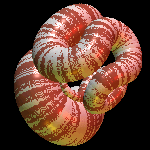 (Select image at left to see detail of a computer graphical simulation of the fossil seashell, Nipponites.)
(Select image at left to see detail of a computer graphical simulation of the fossil seashell, Nipponites.)
Iteration procedures for biological pattern generation are particularly useful for bizarre varieties of seashells on the borderline between deterministic classical equiangular spirals on the one hand and unstable oscillations on the other.
Phylum Mollusca is the second largest phylum of the animal kingdom, and is made up of such forms as clams, snails, slugs and octopuses. The group has enormous diversity, both in shape and size, ranging from the twisted, wormlike solenogastrids to the baglike octopuses. Cephalopods represent the most specialized of the molluscan group and include octopuses, cuttlefish, squids and nautiluses. One group of cephalopods, the ammonoids reached their peak in the Mesozoic era and became extinct at the end of the Cretaceous period. It is known that ammonoids avoided the extensive shallows in which large dinosaurs sometimes swam and their sizes ranged from tiny shells of 1/2 inch diameter to some with a diameter of 6 to 7 feet.
For software and background on the mathematics of these seashell forms, see Pickover, C. (1994) Computers and the Imagination (St. Martin's Press).
Acknowledgment: The seashell growth research is a collaboration with theoretical chonchcologist, Christ Illert.
Back to Cliff Pickover's homepage.